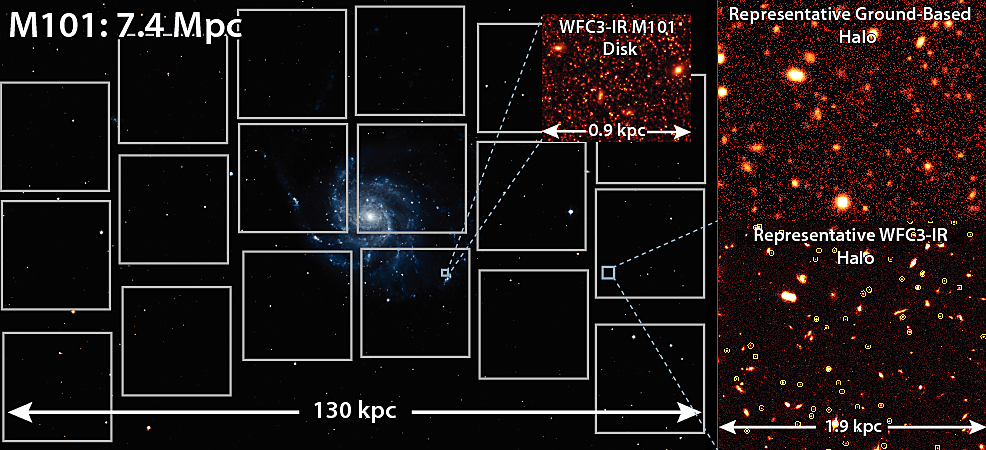 Figure Description: Example of a WFIRST galaxy-mapping observation. The combination of the wide field and high spatial resolution allows us to map the stellar halo to
large distances by separating the sparsely-populated stars from background galaxies while also providing a rich data set for resolved stellar popula
tions in the main body of the galaxy.
Left: Sky survey image of M101 with a single WFIRST footprint
overlaid. Right: High-quality ground-based (top) and WFC3-IR data (bottom)
from a representative low stellar density field are shown to highlight WFIRST's ability to distinguish faint stars (circled on the WFC3-IR image) fr
om galaxies. Inset: WFC3-IR data from the tiny marked region in the main body of M101, showing the exquisite resolution and rich data set of
resolved stellar photometry.
Figure Description: Example of a WFIRST galaxy-mapping observation. The combination of the wide field and high spatial resolution allows us to map the stellar halo to
large distances by separating the sparsely-populated stars from background galaxies while also providing a rich data set for resolved stellar popula
tions in the main body of the galaxy.
Left: Sky survey image of M101 with a single WFIRST footprint
overlaid. Right: High-quality ground-based (top) and WFC3-IR data (bottom)
from a representative low stellar density field are shown to highlight WFIRST's ability to distinguish faint stars (circled on the WFC3-IR image) fr
om galaxies. Inset: WFC3-IR data from the tiny marked region in the main body of M101, showing the exquisite resolution and rich data set of
resolved stellar photometry.
WFIRST's combination of wide field and high resolution will revolutionize the study of nearby galaxies. We propose to produce and analyze simulated WFIRST data of nearby galaxies and their halos to maximize the scientific yield in the limited observing time available, ensuring the legacy value of WFIRST's eventual archive. We will model both halo structure and resolved stellar populations to optimize WFIRST's constraints on both dark matter and galaxy formation models in the local universe.
WFIRST can map galaxy structure down to ~35 mag/square arcsecond using individual stars. The resulting maps of stellar halos and accreting dwarf companions will provide stringent tests of galaxy formation and dark matter models on galactic (and even sub-galactic) scales, which is where the most theoretical tension exists with the Lambda-CDM model. With a careful, coordinated plan, WFIRST can be expected to improve current sample sizes by 2 orders of magnitude, down to surface brightness limits comparable to those currently reached only in the Local Group, and that are >4 magnitudes fainter than achievable from the ground due to limitations in star-galaxy separation.
WFIRST's maps of galaxy halos will simultaneously produce photometry for billions of stars in the main bodies of galaxies within 10 Mpc. These data will transform studies of star formation histories that track stellar mass growth as a function of time and position within a galaxy. They also will constrain critical stellar evolution models of the near-infrared bright, rapidly evolving stars that can contribute significantly to the integrated light of galaxies in the near-infrared. Thus, with WFIRST we can derive the detailed evolution of individual galaxies, reconstruct the complete history of star formation in the nearby universe, and put crucial constraints on the theoretical models used to interpret near-infrared extragalactic observations.
We propose a three-component work plan that will ensure these gains by testing and optimizing WFIRST observing strategies and providing science guidance to trade studies of observatory requirements such as field of view, pixel scale and filter selection. First, we will perform extensive simulations of galaxies' halo substructures and stellar populations that will be used as input for optimizing observing strategies and sample selection. Second, we will develop a pipeline that optimizes stellar photometry, proper motion, and variability measurements with WFIRST. This software will: maximize data quality & scientific yield; provide essential, independent calibrations to the larger WFIRST efforts; and rapidly provide accurate photometry and astrometry to the community. Third, we will derive quantitative performance metrics to fairly evaluate trade-offs between different survey strategies and WFIRST performance capabilities. The end result of this effort will be: (1) an efficient survey strategy that maximizes the scientific yield of what would otherwise be a chaotic archive of observations from small, un-coordinated programs; (2) a suite of analysis tools and a state-of-the-art pipeline that can be deployed after launch to rapidly deliver stellar photometry to the public; (3) a platform to independently verify the calibration and point spread function modeling that are essential to the primary WFIRST goals, but that are best tested from images of stellar populations.
These activities will be carried out by a Science Investigation Team that has decades of experience in using nearby galaxies to inform fundamental topics in astrophysics. This team is composed of researchers who have led the charge in observational and theoretical studies of resolved stellar populations and stellar halos. With our combined background, we are poised to take full advantage of the large field of view and high spatial resolution WFIRST will offer.
